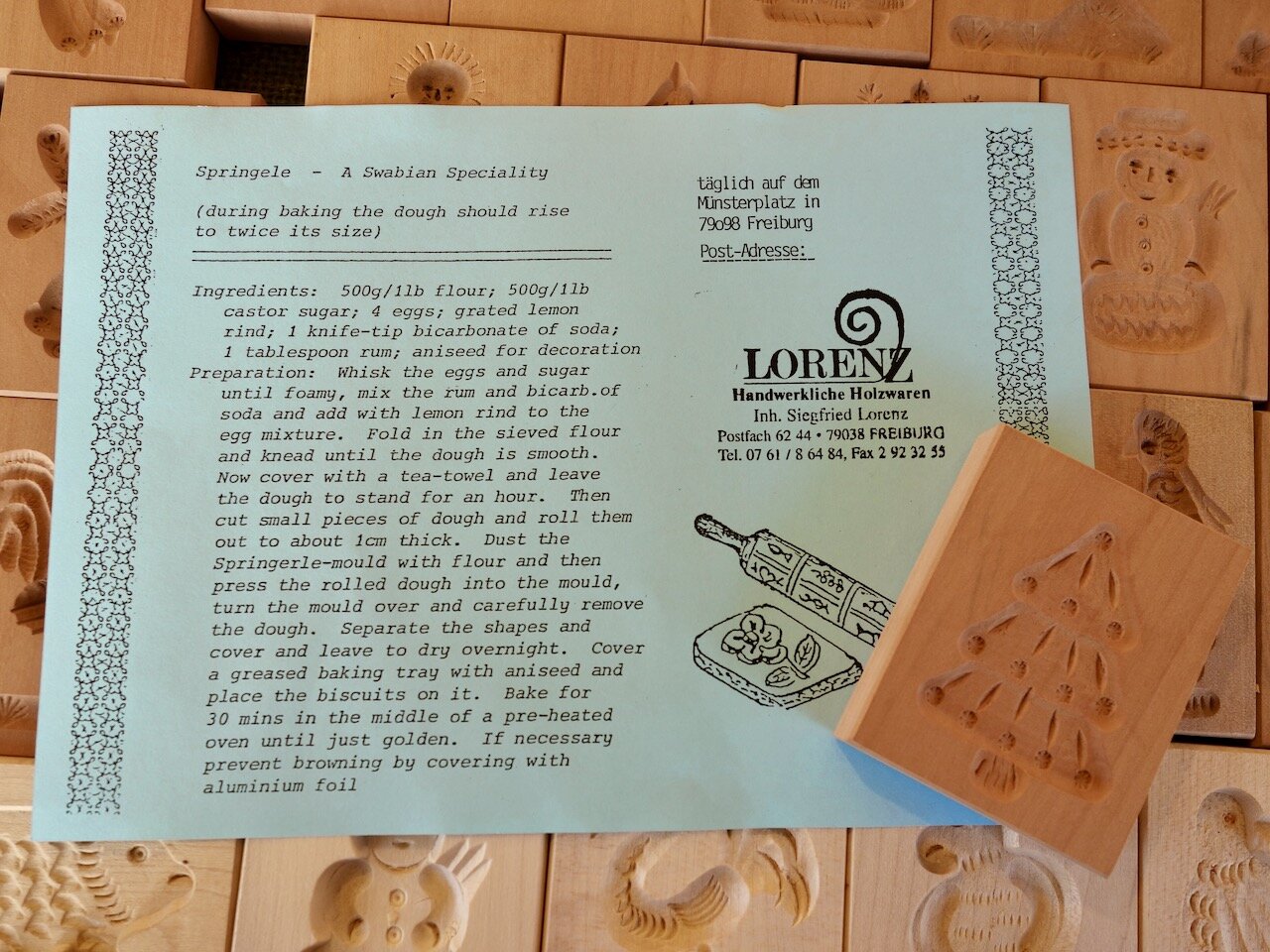December 7: Traditional Swabian Springerle Cookies from Germany
It’s Christmastime and that means Christmas cookies! You probably have your own traditions and favorites, but might I encourage you to add something new to your holiday treats?
Farmers Market in the shadow of the Freiburg cathedral
Image | Trish Feaster
A few years ago, while doing guidebook research for Rick Steves’ Germany guidebook in Freiburg, in the main square beneath the shadow of the city’s impressive Romanesque cathedral, I got to talking with a delightful young woman selling cookie molds and learned all about a specialty of the region of Swabia. Her booth was stocked from floor to canvas ceiling with wooden blocks of various shapes and sizes, each with whimsical and elaborate carved designs.
A plethora of springerle molds await you in Freiburg.
Image | Trish Feaster
While they can be used for lots of different kinds of cookies, they’re meant for the Swabian specialty, springerle, or “little jumper cookies,” so called because of how they “jump up” while baking, as one theory goes. Dating back to the 1300s of this southern Germany region, these fat-free (yes, fat-free) cookies were shared during religious observances and considered good luck charms or tokens of happiness. And while they’re now often associated with Christmastime, they’re enjoyed all year long.
It’s said that in the Middle Ages, German guild bakers not only had to prove their baking abilities but also their carving skills, so they created highly detailed and intricate designs for these baked goods, demonstrating not one but two of their talents. Historical molds show religious designs (used to mark sacramental breads for Christian rites). Over the centuries, molds with knights, portraits, carriages, nature, hearts, and everyday scenes have ebbed in popularity. These days, if you can’t make it to Germany, you can find traditional wooden springerle molds and rolling pins on Etsy and even Amazon. They’re great for biscuit-type cookies like springerle, shortbread, gingerbread, and sugar cookies—and they’re great for dunking into your favorite hot beverage. I like mine with coffee.
Christmastime (or anytime) cookie treats from Swabia in Germany
Image | Trish Feaster
But even if you don’t have one of those authentic molds or pins, you can try out this Swabian springerle recipe (adapted from Lorenz Handwerkliche Holzwaren in Freiburg, Germany and The Spruce Eats) and use your own designs or cookie cutters:
Prep: 60 mins
Cook: 20 mins
Drying time: 24 hrs (up to 48hrs as you prefer)
Total: 25 hrs 20 mins
Servings: 48-60 servings (depending on size of mold)
INGREDIENTS
500g (4 cups) All-purpose flower
500g (5 cups) Confectioner’s sugar (sifted)
4 large eggs
1 medium lemon’s worth of zest
¼ tsp of baking soda or or ammonium carbonate (hirschornsalz)
1 tbsp of rum
Aniseed for decoration
PREPARATION
• In a large bowl, whisk together the eggs until thick and foamy.
• Adding small amounts at a time, mix the confectioner’s sugar with the eggs for 10 minutes (stand mixer).
• In a separate bowl, dissolve the baking soda in the rum. Then add rum, along with lemon zest to egg mixture and mix well (10 minutes on low if using stand mixer).
• Add sifted flower in small amounts and knead until smooth and soft. If too stiff, mix in a little more liquid.
• Form dough into a smooth ball and let rest for 1-2 hours in bowl. Be sure to cover.
• Lightly dust work surface with sugar or cornstarch. Cut dough into quarters. Work with one quarter at a time (keeping the rest covered to prevent drying out) and roll out to 1cm (just under ½-inch) thick.
• Use springerle mold or rolling pin to emboss the cookies.
• Cut out the embossed shapes using a knife, small roller cutter, biscuit cutter, etc.
• Transfer to baking sheet or wooden board lightly dusted with sugar or cornstarch. Let dry for 24-48 hours. This process is crucial for settling and will permit the cookie to “jump up”, separating slightly into two layers, a yellow-gold little foot or füßleand a white crust-like top. • Before baking, wet the bottom of the cookies by laying them on a clean, moist kitchen towel
• Line a baking pan with parchment and sprinkle with aniseed. If using silicone mat, sprinkle aniseed directly onto the mat. Set the cookies on top.
• Bake at 300F (150C) for 10 minutes, then lower temperature to 280F (140C) and bake for 10 more minutes. To prevent browning, you can cover with aluminum foil.
• Remove and let cool.
Cookies will initially be hard and biscuit-like. Over time, they will soften a bit and are best enjoyed when dunked in coffee or another hot beverage. Store in air-tight container to keep springerle moist.
Guten Appetit und Frohe Weihnachten!
Lorenz Handwerkliche Holzwaren’s Springerle recipe and molds
Image | Trish Feaster




